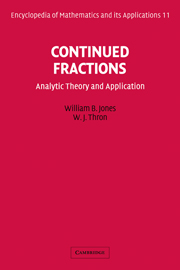Book contents
- Frontmatter
- Contents
- Editor's Statement
- Section Editor's Foreword
- Introduction by Peter Henrici
- Preface
- Symbols
- Continued Fractions
- Chapter 1 Introduction
- Chapter 2 Elementary Properties of Continued Fractions
- Chapter 3 Periodic Continued Fractions
- Chapter 4 Convergence of Continued Fractions
- Chapter 5 Methods for Representing Analytic Functions by Continued Fractions
- Chapter 6 Representations of Analytic Functions by Continued Fractions
- Chapter 7 Types of Corresponding Continued Fractions and Related Algorithms
- Chapter 8 Truncation-Error Analysis
- Chapter 9 Asymptotic Expansions and Moment Problems
- Chapter 10 Numerical Stability in Evaluating Continued Fractions
- Chapter 11 Application of Continued Fractions to Birth-Death Processes
- Chapter 12 Miscellaneous Results
- Appendix A Classification of Special Types of Continued Fractions
- Appendix B Additional Results on Minimal Solutions of Three-Term Recurrence Relations
- Bibliography
- Author Index
- Subject Index
Chapter 5 - Methods for Representing Analytic Functions by Continued Fractions
Published online by Cambridge University Press: 04 August 2010
- Frontmatter
- Contents
- Editor's Statement
- Section Editor's Foreword
- Introduction by Peter Henrici
- Preface
- Symbols
- Continued Fractions
- Chapter 1 Introduction
- Chapter 2 Elementary Properties of Continued Fractions
- Chapter 3 Periodic Continued Fractions
- Chapter 4 Convergence of Continued Fractions
- Chapter 5 Methods for Representing Analytic Functions by Continued Fractions
- Chapter 6 Representations of Analytic Functions by Continued Fractions
- Chapter 7 Types of Corresponding Continued Fractions and Related Algorithms
- Chapter 8 Truncation-Error Analysis
- Chapter 9 Asymptotic Expansions and Moment Problems
- Chapter 10 Numerical Stability in Evaluating Continued Fractions
- Chapter 11 Application of Continued Fractions to Birth-Death Processes
- Chapter 12 Miscellaneous Results
- Appendix A Classification of Special Types of Continued Fractions
- Appendix B Additional Results on Minimal Solutions of Three-Term Recurrence Relations
- Bibliography
- Author Index
- Subject Index
Summary
This chapter deals with the representation of analytic functions by continued fractions. Two main approaches are considered. In the first approach a formal continued-fraction expansion is obtained by requiring that the Laurent expansion of the nth approximant agree term by term with a given Laurent series L up to the νn power of z, where νn tends to infinity with n. Continued fractions defined in this manner are said to correspond to the series L [or to the function ƒ(z) of which L is a Laurent expansion]. A general theory of correspondence is developed in Sections 5.1, 5.2, and 5.4 for sequences of functions {Rn(z)} meromorphic at the origin. As a special case Rn(z) can be the nth approximant of a continued fraction. A norm is introduced for the field of all formal Laurent series, such that convergence with respect to the norm is equivalent to correspondence. Necessary and sufficient conditions for the existence of a Laurent series L to which a given sequence {Rn(z)} corresponds are given by Theorem 5.1. A method for obtaining a sequence {Rn(z)} (or continued fraction) corresponding to a given Laurent series L is provided by Theorems 5.2 and 5.3, in which three-term recurrence relations play an important role. As a consequence of the property of correspondence, it is shown (Section 5.4) that, with suitable restrictions, uniform convergence of a sequence {Rn(z)} is equivalent to uniform bounded-ness, and that when a sequence {Rn(z)} converges uniformly, its limit ƒ(z) is a function whose Laurent expansion is L. Although the basic ideas of correspondence go back to Gauss [1813], the general theory described here is based on [Jones and Thron, 1975, 1979].
- Type
- Chapter
- Information
- Continued FractionsAnalytic Theory and Applications, pp. 147 - 197Publisher: Cambridge University PressPrint publication year: 1984



